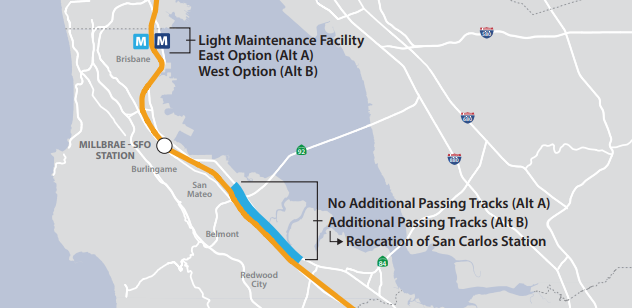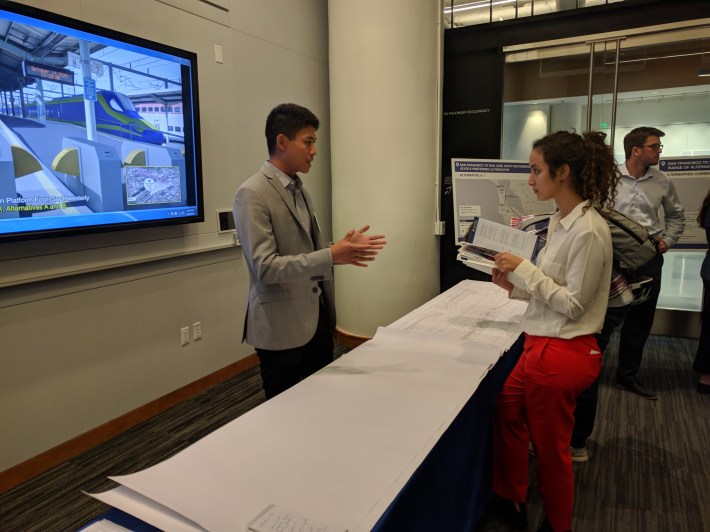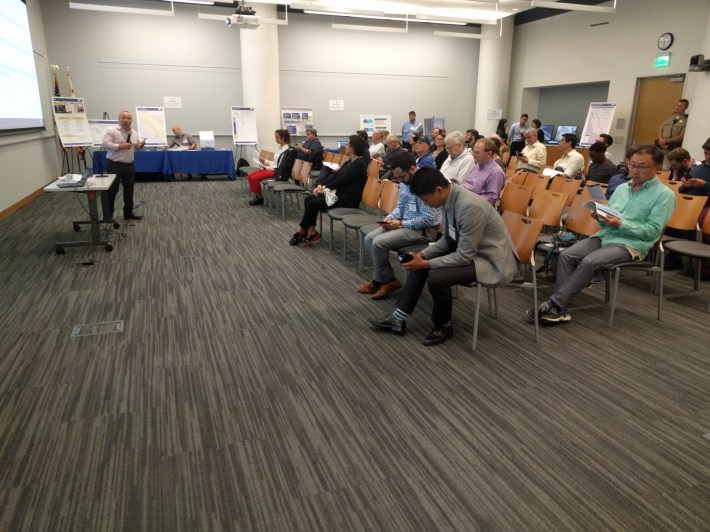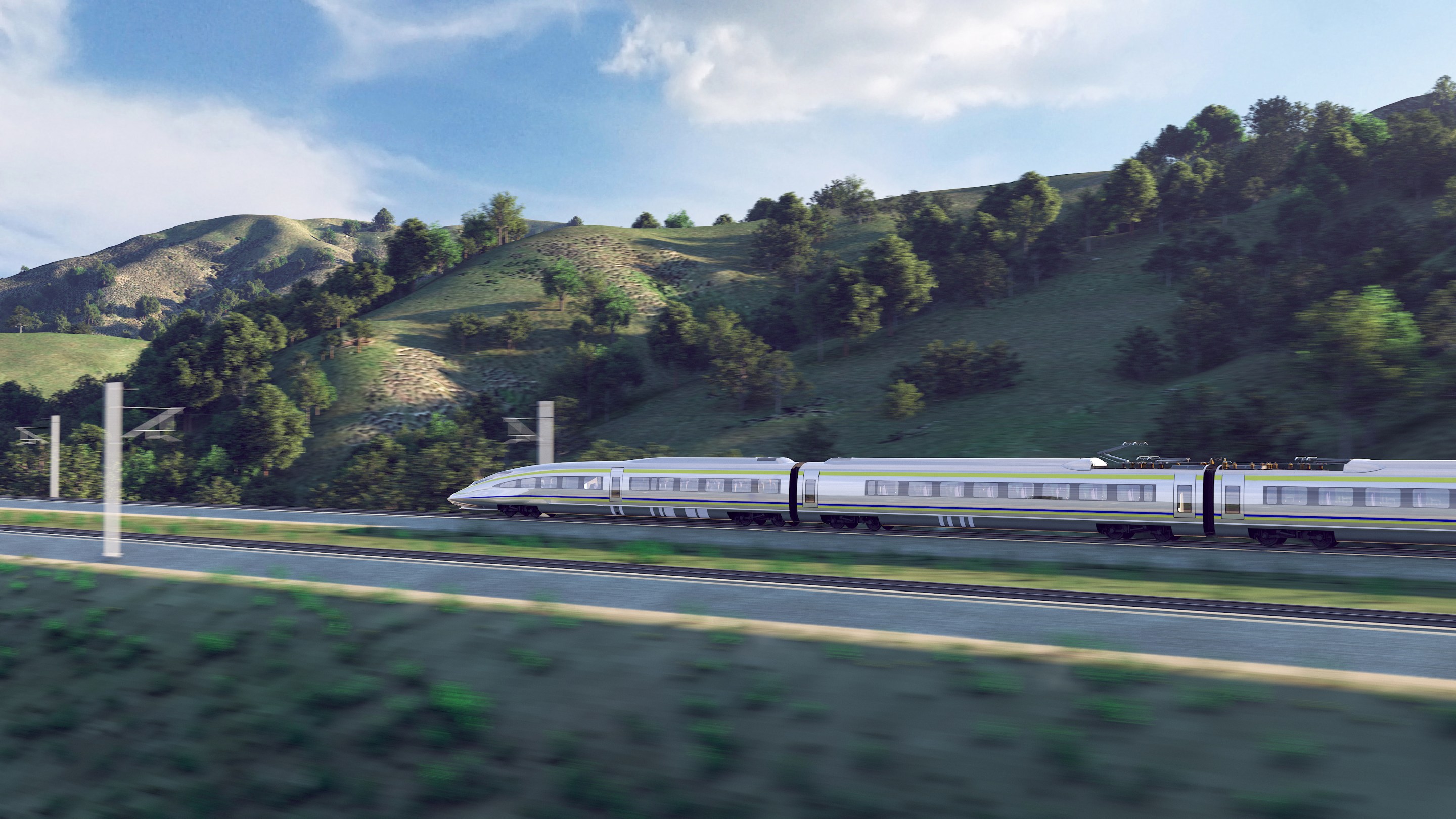Note: Metropolitan Shuttle, a leader in bus shuttle rentals, regularly sponsors coverage on Streetsblog San Francisco and Streetsblog Los Angeles. Unless noted in the story, Metropolitan Shuttle is not consulted for the content or editorial direction of the sponsored content.
Should the maintenance yard be on the east or west side of the mainline in Brisbane and is there a need for additional passing tracks between San Mateo and Redwood City? These are two of the last few remaining details on the Peninsula that need to be sorted as the California High-speed Rail project completes its designs on the route that will one day connect the Central Valley to San Francisco via Caltrain's Peninsula corridor.
"In 2012, we made a decision to operate in the blended configuration," explained James Tung, a manager with the High-speed Rail Authority, at a presentation to the public held Monday evening at the Bay Area Metro Center in Rincon Hill about the handful of remaining decisions that have to be made in the designs. "In 2013 we came out with five different options for passing tracks, put together several time tables, and the general conclusion is even without passing tracks we can add six-plus-four service."

That means without widening the footprint of Caltrain's right-of-way, which will share trains with high-speed rail, it will still be possible to run six Caltrains an hour plus four high-speed trains an hour, during peak periods, all at 110 mph. Of course, that will depend on Caltrain, the host railroad, completing its $2 billion electrification project and some additional feathering of curves.
So the HSR staff engineers are recommending that they leave well-enough alone and not build additional passing tracks. But not everyone who attended last night's presentation was convinced that's the right choice. "I've ridden high-speed rail in Japan," said Farah Soltane, a transit engineer with Acumen who came to the meeting to learn about the project. "I think we're missing out."
Soltane thinks the priority should be squeezing as much speed out of the trains as possible. "That's where you get the passengers; when you're faster overall."

But Tung reiterated that the idea of fully grade-separating and expanding the alignment to four tracks was abandoned years ago. That means grade-crossings will remain and speeds will be limited to 110 mph by regulations; meaning additional passing tracks just aren't that significant given the speed cap.
Nevertheless, it seemed like several people visiting the meeting were disappointed by the politics and compromises. "I want a better future," said Theodore Randolph, who lives in San Francisco. "I want to be able to go between San Francisco and Los Angeles and have a smaller environmental impact."

The above chart lays out why staff is recommending against additional passing tracks (keep in mind there are already passing segments thanks to Caltrain's 'Baby Bullet' project, completed in 2004). It would cost roughly a billion more to add more tracks, and it would bring another political firestorm from NIMBYs, with little time savings to show for it.
And it's perhaps worth repeating that European high-speed rail systems were built with "blended" tracks at the bookends, where the HSR trains enter cities by sharing commuter train tracks through the suburbs and more densely populated areas. Once HSR service is established, parallel tracks are added and speeds raised over time. The most obvious example of this process is the 'Eurostar' that connects London to Paris and Brussels. In 1994, service began on a dedicated high-speed line in France between the Parisian suburbs and the channel tunnel, but it used a relatively slow track segment between the English channel and central London. For years, Eurostar shared tracks with commuter trains, on a line with grade crossings, not unlike the busy Caltrain corridor--speeds were limited to only 90 mph. To make this happen, a specially designed HSR train had to be built that could also use two types of electrification.
Thirteen years later, a fully high-speed line, enabling trains to travel at 186 mph and faster almost all the way into London was opened, cutting almost 35 minutes off the trip between Paris and London. In addition, in the earlier phase, trains went to London's Waterloo Station, two miles from the heart of London, just as California HSR will go to 4th and King until the downtown tracks are connected to the Salesforce Transit Center. The British also connected the new tracks, via their own "downtown extension" to the more central St. Pancras station. In Europe, speeds were and continue to be increased--and ridership continues to grow. Representatives from the Authority agreed that California's system will follow a similar pattern of stepped improvements after the line is operational.

For Boris Lipkin, Northern California Regional Director for the project, the outreach meetings are also an opportunity to remind the Bay Area public that high-speed rail construction is already well underway, with massive projects in the Central Valley, and planning getting completed to connect that spine to San Jose and San Francisco with brand new tracks through the Pacheco Pass.
The idea, for now, is to get some kind of stop-gap service going as soon as possible. The feeling is that as with the Eurostar and other services in Europe, once trains are zooming along at 200-plus mph, the question of further improvements will shift from "do we need this" to "when can we get this here?"
"The governor wants us to build everything we can, extending to Merced and Bakersfield," he said in his presentation. That 119-mile line, which should be operational by 2029, will connect to the Bay Area, in the short term, via Amtrak and ACE's existing alignment. The Authority has already spent $5 billion on 24 active construction sites, producing some 3,000 construction jobs in the Central Valley. "While we do that, he wants us to maintain a commitment to the bookend projects. That means Caltrain electrification, as well as projects in Southern California."
The project team has put together a video, showing the construction in the Central Valley and the planning for the bookends and the connection from Merced to San Jose.
But first, of course, the Authority has to vote on the maintenance yard and additional passing tracks. And that means collecting more public comment. The next open house about the last decisions and refinement on the Peninsula designs will be held Thursday, August 15, from 5 p.m.-8 p.m. (Presentations begin at 5:45 p.m.), at the San House City Hall, Council Chambers, 200 E Santa Clara Street, San Jose. For a full list of open houses, check out the Authority's calendar. You can also comment online.
The California High-speed Rail board will make its final determination on the passing tracks and location of the maintenance facility on September 17.





